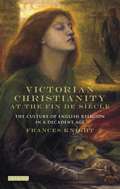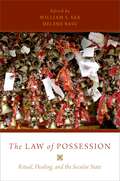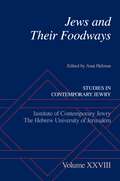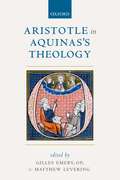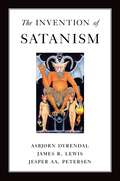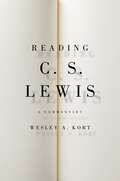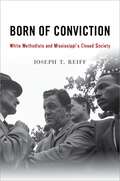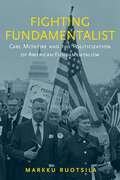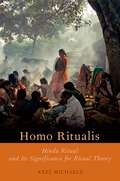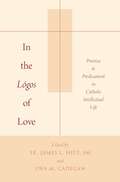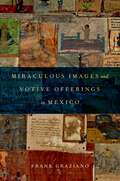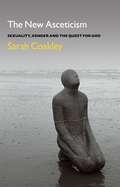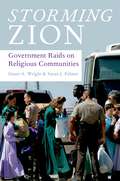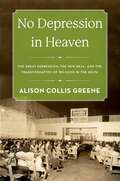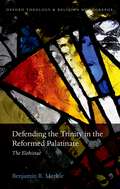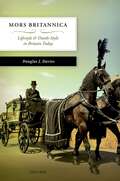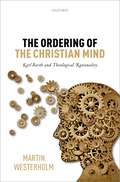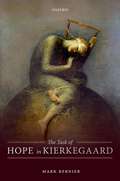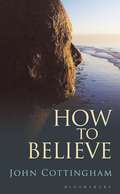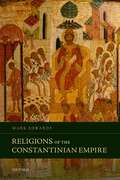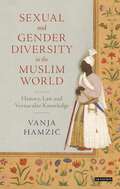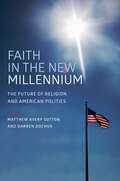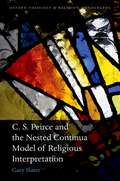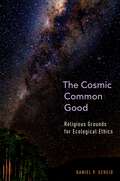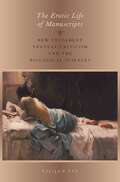- Table View
- List View
Victorian Christianity at the Fin de Siècle: The Culture of English Religion in a Decadent Age
by Frances KnightThe period known as the fin de siecle - defined in this groundbreaking book as chiefly the period between1885 and 1901 - was a fluid and unsettling epoch of optimism and pessimism, endings and beginnings, aswell as of new forms of creativity and anxiety. The end of the century has attracted much interest from scholars of literary and cultural studies, who regard it as a critical moment in the history of their disciplines; but it has been relatively ignored by religious historians. Frances Knight here sets right that neglect. She shows how late Victorian society (often said to be one of the most intensely Christian cultures the world has ever seen) reacted to the bold agendas being set by the thinkers of the fin de siecle; and how prominent Church figures during the era first identified many of the concerns that have preoccupied Christians latterly. These include an active interest in social justice and the creation of new types of communities; increasingly open discussion of the sexual exploitation of children; debates about society's 'decadence'; new ideas about the role of women; and the belief in the redemptive powers of art, pioneered by figures as diverse as P.T.Forsyth, Percy Dearmer and Samuel and Henrietta Barnett.Examining in particular the Christian world of fin de siecle London, the author offers penetrating insights intoa society in which the ritual and culture of Christianity sometimes permeated the aesthetic movement andwhere devotees of the aesthetic movement - like Walter Pater, Oscar Wilde and their disciples - often revealed a fascination with Christianity. She argues that the 'long 1890s' was a decisive decade in which various sections of Christian opinion, both on the progressive and the more conservative wings of the faith, began to express views which set the tone for attitudes which would become commonplace in the twentieth century. Victorian Christianity at the Fin de Siecle is the focussed treatment of religion and culture at the end of the nineteenth century that the field has long needed. It will be welcomed by scholars of church history, social and cultural history and the history of ideas.
The Law of Possession: Ritual, Healing, and the Secular State
Rituals combining healing with spirit possession and court-like proceedings are found around the world and throughout history. For example, a person suffers from an illness that cannot be cured, and in order to be healed he performs a ritual involving prosecution and defense, a judge and witnesses. Divine beings give evidence through human oracles, spirits possess their human victims and are exorcized, and local gods intervene to provide healing and justice. Such practices seem to be the very antithesis of modernity and many modern, secular states have systematically attempted to eliminate them. Why are such rituals largely absent from modern societies, and what happens to them when the state attempts to expunge them from their health and justice systems, or even to criminalize them? Despite the prevalence of rituals involving some or all of these elements, The Law of Possession represents the first attempt to compare and analyze them systematically. The volume brings together historical and contemporary case studies from East Asia, South Asia, and Africa, and argues that, despite consistent attempts by states to discourage, eliminate, and criminalize them, such rituals persist and even thrive because they meet widespread human needs.
Jews and Their Foodways (Studies in Contemporary Jewry)
Food is not just a physical necessity but also a composite commodity. It is part of a communication system, a nonverbal medium for expression, and a marker of special events. Bringing together contributions from fourteen historians, anthropologists, sociologists, and literary critics, Volume XXVIII of Studies in Contemporary Jewry presents various viewpoints on the subtle and intricate relations between Jews and their foodways. The ancient Jewish community ritualized and codified the sphere of food; by regulating specific and detailed culinary laws, Judaism extended and accentuated food's cultural meanings. Modern Jewry is no longer defined exclusively in religious terms, yet a decrease in the role of religion, including kashrut observance, does not necessarily entail any diminishment of the role of food. On the contrary, as shown by the essays in this volume, choices of food take on special importance when Jewish individuals and communities face the challenges of modernity. Following an introduction by Sidney Mintz and concluding with an overview by Richard Wilk, the symposium essays lead the reader from the 20th century to the 21st, across Europe, the Middle East, Africa, and North America. Through periods of war and peace, voluntary immigrations and forced deportations, want and abundance, contemporary Jews use food both for demarcating new borders in rapidly changing circumstances and for remembering a diverse heritage. Despite a tendency in traditional Jewish studies to focus on "high" culture and to marginalize "low" culture, Jews and Their Foodways demonstrates how an examination of people's eating habits helps to explain human life and its diversity through no less than the study of great events, the deeds of famous people, and the writings of distinguished rabbis.
Aristotle in Aquinas's Theology
Aristotle in Aquinas's Theology explores the role of Aristotelian concepts, principles, and themes in Thomas Aquinas's theology. Each chapter investigates the significance of Aquinas's theological reception of Aristotle in a central theological domain: the Trinity, the angels, soul and body, the Mosaic law, grace, charity, justice, contemplation and action, Christ, and the sacraments. In general, the essays focus on the Summa theologiae, but some range more widely in Aquinas's corpus. For some time, it has above all been the influence of Aristotle on Aquinas's philosophy that has been the centre of attention. Perhaps in reaction to philosophical neo-Thomism, or perhaps because this Aristotelian influence appears no longer necessary to demonstrate, the role of Aristotle in Aquinas's theology presently receives less theological attention than does Aquinas's use of other authorities (whether Scripture or particular Fathers), especially in domains outside of theological ethics. Indeed, in some theological circles the influence of Aristotle upon Aquinas's theology is no longer well understood. Readers will encounter here the great Aristotelian themes, such as act and potency, God as pure act, substance and accidents, power and generation, change and motion, fourfold causality, form and matter, hylomorphic anthropology, the structure of intellection, the relationship between knowledge and will, happiness and friendship, habits and virtues, contemplation and action, politics and justice, the best form of government, and private property and the common good. The ten essays in this book engage Aquinas's reception of Aristotle in his theology from a variety of points of view: historical, philosophical, and constructively theological.
The Invention of Satanism
by Asbjorn Dyrendal James R. Lewis Jesper Aa. PetersenSatanism is a complex phenomenon that has often been the source of controversy across social and rhetorical contexts. Some consider it the root of all evil. Others see it as a childish form of rebellion or as a misapplication of serious esoteric beliefs and practices. Still others consider it a specific religion or philosophy that serves as a form of personal and collective identity. In The Invention of Satanism, three experts explore Satanism as a contemporary movement that is in continuous dialogue with popular culture, and which provides a breeding ground for other new religious movements. By shifting the focus from mythology to meaning-making, this book examines the invention of Satanism among self-declared religious Satanists. Like all ideologists and believers, Satanists incorporate, borrow, and modify elements from other traditions; the authors investigate how traditional folklore and prior strands of occultism were synthesized by Anton LaVey in his founding of the Church of Satan and creation of the Satanic Bible. Later chapters discuss contemporary Satanist subcultures, demonstrating how Satanism continues to reinvent itself despite its brief history as an organized phenomenon. There are now numerous forms of Satanism with distinctive interpretations of what being a Satanist entails, with some of these new versions deviating more from the historical "mainstream" than others. In this fascinating account of a seemingly arcane and often-feared movement, Dyrendal, Lewis, and Petersen demonstrate that the invention of Satanism is an ongoing, ever-evolving process.
Reading C.S. Lewis: A Commentary
by Wesley A. KortFrom the unbending belief in invisible powers that animates Till We Have Faces to the depiction of Aslan's sacrifice and resurrection in The Lion, The Witch, and the Wardrobe, C. S. Lewis's writing has sparked intense debate about the presence and function of religion in his works. Today, a reader's opinion of Lewis is more often than not based on his or her perspectives on religion. In Reading C. S. Lewis, Wesley A. Kort examines Lewis's work as a whole, investigating why and at what points Lewis turns to religion-and particularly to Christianity-in order to advance his arguments. Kort moves through more than a dozen of Lewis's major books, providing a useful guide to their various elements while connecting readers to the literary contexts that influenced the works and Lewis himself. Reading C. S. Lewis examines the standing of Lewis's work, how best to approach the books, and the misunderstandings that lead to mistaken readings. The commentaries also function as free-standing essays that can be read individually and in any order. Reading C. S. Lewis: A Commentary sets a new standard for C. S. Lewis studies. A comprehensive examination of the major Lewis texts, this volume is a captivating look into the author's work from a refreshingly undogmatic point of view.
Born of Conviction: White Methodists and Mississippi's Closed Society
by Joseph T. ReiffWinner of the Mississippi Institute of Arts and Letters' Nonfiction Award The dominant narrative of the role of white citizens and the white church in Mississippi's civil rights era focuses on their intense resistance to change. The "Born of Conviction" statement, signed by twenty-eight white Methodist pastors and published in the Mississippi Methodist Advocate on January 2, 1963, offered an alternative witness to the segregationist party line. Calling for freedom of the pulpit and reminding readers of the Methodist Discipline's claim that the teachings of Jesus permit "no discrimination because of race, color, or creed," the pastors sought to speak to and for a mostly silent yet significant minority of Mississippians, and to lead white Methodists to join the conversation on the need for racial justice. The document additionally expressed support for public schools and opposition to any attempt to close them, and affirmed the signers' opposition to Communism. Though a few individuals, both laity and clergy, voiced public affirmation of "Born of Conviction," the overwhelming reaction was negative-by mid-1964, eighteen of the signers had left Mississippi, evidence of the challenges faced by whites who offered even mild dissent to massive resistance in the Deep South. Dominant narratives, however, rarely tell the whole story. The statement caused a significant crack in the public unanimity of Mississippi white resistance. Signers and their public supporters also received private messages of gratitude for their stand, and eight of the signers would remain in the Methodist ministry in Mississippi until retirement. Born of Conviction tells the story of "the Twenty-Eight" illuminating the impact on the larger culture of this attempt by white clergy to support race relations change. The book explores the theological and ethical understandings of the signers through an account of their experiences before, during, and after the statement's publication. It also offers a detailed portrait of both public and private expressions of the theology and ethics of white Mississippi Methodists in general, as revealed by their responses to the "Born of Conviction" controversy.
Fighting Fundamentalist: Carl McIntire and the Politicization of American Fundamentalism
by Markku RuotsilaFor most of his sixty-year career, the Reverend Carl McIntire was at the center of controversy. The best-known and most influential of the fundamentalist radio broadcasters and anticommunists of the Cold War era, his many enemies depicted him as a dangerous far rightist, a racist, or a "McCarthyite" opportunist engaged in red-baiting for personal profit. Despised and hounded by liberals, revered by fundamentalists, and distrusted by the center, he became a lightning rod in the early days of America's culture wars. Markku Ruotsila's Fighting Fundamentalist, the first scholarly biography of McIntire, peels off the accumulated layers of caricature and makes a case for restoring McIntire to his place as one of the most consequential religious leaders in the twentieth-century United States. Ruotsila traces McIntire's life from his early twentieth-century childhood in Oklahoma to his death in 2002. From his discipleship under J. Gresham Machen during the fundamentalist-modernist controversy, through his fifty-year pastorate in Collingswood, New Jersey, and his presidency of the International Council of Christian Churches, McIntire, Ruotsila shows, stands out as the most important fundamentalist of his time. Drawing on exhaustive research in fifty-two archival collections-including the recently opened collection of the Carl McIntire papers and never-before-seen FBI files-Ruotsila looks beyond the McIntire of legend to discover a serious theological, political, and economic combatant, a tireless organizer who pioneered the public theologies, inter-faith alliances, and political methods that would give birth to the Christian Right. The moral values agenda of the 1970s and after would not have existed, Ruotsila shows, without the anti-communist and anti-New Deal activism that McIntire inaugurated. Indeed, twentieth-century American religious and political history were profoundly shaped by forces McIntire set in motion. Fighting Fundamentalist tells the overlooked story of McIntire and the movement he inspired.
Homo Ritualis: Hindu Ritual and Its Significance for Ritual Theory (Oxford Ritual Studies)
by Axel MichaelsIs the richness and diversity of rituals and celebrations in South Asia unique? Are Indians or Hindus more involved in rituals than people of other faiths and other places? If so, what makes them special? Can we speak of a homo ritualis when it comes to India or Hinduism? Drawing on extensive textual studies and fieldwork in Nepal and India, Axel Michaels demonstrates how the characteristic structure of Hindu rituals employs the Brahmanic-Sanskritic sacrifice as a model, and how this structure is one of the distinguishing features of Hinduism more generally. Many religions tend over time to develop less ritualized or more open forms of belief, but Brahmanical Hinduism has internalized ritual behavior to the extent that it has become its most important and distinctive feature, permeating social and personal life alike. The religion can thus be seen as a particular case in the history of religions in which ritual form dominates belief and develops a sweeping autonomy of ritual behavior. Homo Ritualis analyzes ritual through these cultural-specific and religious contexts, taking into account how indigenous terms and theories affect and contribute to current ritual theory. It describes and investigates various forms of Hindu rituals and festivals, such as life-cycle rituals, the Vedic sacrifice, vows processions, and the worship of deities (puja). It also examines various conceptual components of (Hindu) rituals such as framing, formality, modality, and theories of meaning.
In the Lógos of Love: Promise and Predicament in Catholic Intellectual Life
So much has changed about Catholic intellectual life in the half century since the end of the Second Vatican Council that it has become difficult to locate the core concepts that make up the tradition. In the Lógos of Love is a collection of essays that grew out of a 2013 conference on Catholic intellectual life co-sponsored by the University of Dayton and the Institute for Advanced Catholic Studies at the University of Southern California. The essays, written by scholars of theology, history, law, and media studies of religion, trace the history of this intellectual tradition in order to craft new tools for understanding the present day and approaching the future. Each essay explores both the promise of Catholic intellectual life and its various contemporary predicaments. How does a changed media landscape affect the way Catholicism is depicted, and the way its adherents understand and communicate among themselves? What resources can the tradition offer for reflection on new understandings of sexuality and gender? How can and should US Catholic intellectual life embrace and enhance-and introduce students to-the new ways in which Catholicism is becoming a more global tradition? What is the role of scholars in disciplines beyond theology? Of scholars who are not Catholic? Of scholars in universities not sponsored by Catholic religious orders or dioceses? By providing context for and proposing responses to these questions, the scholars invite discussion and reflection from a wide range of readers who have one important thing in common-a stake in sustaining a vibrant, flourishing intellectual tradition.
Miraculous Images and Votive Offerings in Mexico
by Frank GrazianoMexican statues and paintings like the Virgen de Guadalupe and the Señor de Chalma are endowed with sacred presence and the power to perform miracles. Millions of devotees visit their shrines to request miracles for health, employment, children, and countless everyday matters. When miracles are granted, devotees reciprocate with votive offerings. Collages, photographs, documents, texts, milagritos, hair and braids, clothing, retablos, and various representative objects cover walls at many shrines. Miraculous Images and Votive Offerings in Mexico explores such petitionary devotion in depth through extensive fieldwork supported by research in a vast body of interdisciplinary scholarship. The study's principal themes include sacred power and human agency, reification, projective animation, faith as a cognitive filter, sacred power transfer, social and narrative construction, positive framing, collaborative and deferred control, vows (juramentos), and miracle attribution. The book is written in two alternating voices, one interpretive to provide an understanding of miracles, miraculous images, and votive offerings, and the other narrative to illustrate the interpretive chapters and to bring the reader closer to experiences at the shrines. Among the many miraculous images treated in the book are the Cristo Negro de Otatitlán, Niño del Cacahuatito, Señor de Chalma, Señor de la Misericordia (Tepatitlán), Señor del Rayo, Señor de las Tres Caídas (Teotilalpam), Virgen de los Dolores de Soriano, Virgen de Guadalupe, Virgen del Pueblito, Virgen de Juquila, Virgen de los Remedios, Virgen de San Juan de los Lagos, Virgen de Talpa, Virgen de Tonatico, and Virgen de Zapopan.
The New Asceticism: Sexuality, Gender and the Quest for God
by Sarah CoakleyEach chapter of The New Asceticism concentrates on a contentious issue in contemporary theology - the role of women in the churches, homosexuality and the priesthood, celibacy and the future of Christian asceticism - in an original thesis about the nature of desire which may start to heal many contemporary wounds. Professor Coakley is as familiar with the Bible and the Early Fathers as she is with the writings of Freud and Jung, and she draws heavily on Gregory of Nyssa's theology of desire in what she proposes. She points the way through the false modern alternatives of repression and libertinism, agape and eros, recovering a way in which desire can be freed from associations with promiscuity and disorder, and forging a new ascetical vision founded in the disciplines of prayer and attention.
Storming Zion: Government Raids on Religious Communities
by Stuart A. Wright Susan J. PalmerWhile scholars, media, and the public may be aware of a few extraordinary government raids on religious communities, such as the U.S. federal raid on the Branch Davidians in 1993, very few people are aware of the scope of these raids or the frequency with which they occur. Inspired by the Texas State raid on the Fundamentalist Church of Latter-day Saints in 2008, authors Stuart A. Wright and Susan J. Palmer decided to collect data on all the raids of this kind that have taken place in Western-style democracies over the last six decades. They thus established the first archive of raided groups and then used it see if any patterns could be identified. Their findings were shocking; there were far more raids than expected, and the vast majority of them had occurred since 1990, reflecting a nearly exponential increase. What could account for this sudden and dramatic increase in state control of minority religions? In Storming Zion, Wright and Palmer argue that the increased use of these high-risk and extreme types of enforcement corresponds to expanded organization and initiatives by opponents of unconventional religions. Anti-cult organizations provide strategic "frames" that define potential conflicts or problems in a given community as inherently dangerous, and construct narratives that draw on stereotypes of child and sexual abuse, brainwashing, and even mass suicide. The targeted group is made to appear more dangerous than it is, resulting in an overreaction by authorities. Wright and Palmer explore the implications of heightened state repression and control of minority religions in an increasingly multicultural, globalized world. At a time of rapidly shifting demographics within Western societies this book cautions against state control of marginalized groups and offers insight into the reasons why the responses to these groups are often so reactionary.
No Depression in Heaven: The Great Depression, the New Deal, and the Transformation of Religion in the Delta
by Alison Collis GreeneIn No Depression in Heaven, Alison Collis Greene demonstrates how the Great Depression and New Deal transformed the relationship between church and state. Grounded in Memphis and the Delta, this book traces the collapse of voluntarism, the link between southern religion and the New Deal, and the gradual alienation of conservative Christianity from the state. At the start of the Great Depression, churches and voluntary societies provided the only significant source of aid for those in need in the South. Limited in scope, divided by race, and designed to control the needy as much as to support them, religious aid collapsed under the burden of need in the early 1930s. Hungry, homeless, and out-of-work Americans found that they had nowhere to turn at the most desolate moment of their lives. Religious leaders joined a chorus of pleas for federal intervention in the crisis and a permanent social safety net. They celebrated the New Deal as a religious triumph. Yet some complained that Franklin Roosevelt cut the churches out of his programs and lamented their lost moral authority. Still others found new opportunities within the New Deal. By the late 1930s, the pattern was set for decades of religious and political realignment. More than a study of religion and politics, No Depression in Heaven uncovers the stories of men and women who endured the Depression and sought in their religious worlds the spiritual resources to endure material deprivation. Its characters are rich and poor, black and white, mobile sharecroppers and wealthy reformers, enamored of the federal government and appalled by it. Woven into this story of political and social transformation are stories of southern men and women who faced the greatest economic disaster of the twentieth century and tried to build a better world than the one they inhabited.
Defending the Trinity in the Reformed Palatinate: The Elohistae (Oxford Theology and Religion Monographs)
by Benjamin R. MerkleThis study begins with an examination of Girolamo Zanchi's De Tribus Elohim (1572), setting this important defense of the doctrine of the Trinity in the immediate context of the recent rise of antitrinitarianism within the Reformed Palatinate. De Tribus Elohim focused on the grammatical peculiarity of the Hebrew word Elohim (God) in order to refute the biblicism of its contemporary antitrinitarians. In doing so, Zanchi's argument followed an exegetical thread common within the late medieval case for the doctrine of the Trinity, but which ran contrary to the exegetical sensibilities of many of Zanchi's own Reformed colleagues. This disagreement over the correct interpretation of the word Elohim, then became a touchstone for distinguishing between two different approaches to the Hebrew text with the Reformed Church of the late sixteenth century, and becomes a significant piece in understanding the development of Reformed exegesis.
Mors Britannica: Lifestyle & Death-Style in Britain Today
by Douglas J. DaviesA people's lifestyle is one thing, their death-style another. The proximity or distance between such styles says much about a society, not least in Britain today. Mors Britannica takes up this style-issue in a society where cultural changes involve distinctions between traditional religion, secularisation, and emergent forms of spirituality, all of which involve emotions, where fear, longing, and a sense of loss rise in waves when death marks the root embodiment of our humanity. These world-orientations, evident in older and newer ritual practices, engage death in the hope and desire that love, relationships, community, and human identity be not rendered meaningless. Yet both emotions and ritual have an uneasiness to them because 'death' is a slippery topic as the twenty-first century gets under way in Britain. In this work, Douglas J. Davies draws from a largely anthropological-sociological perspective, with consideration of history, literature, philosophy, psychology, and theology, to provide a window into British life and insights into the foundation links between individuals and society, across the spectrum of traditionally religious views through to humanist and secular alternatives. He considers memorial sites (from churchyards to roadside memorials); forms of corporeal disposal (from cremation to composting); and death rites in a range of religious and secular traditions.
The Ordering of the Christian Mind: Karl Barth and Theological Rationality
by Martin WesterholmThe adequacy of Karl Barth's conception of theological reasoning is a decisive point of contention in assessments of the legacy and potential of twentieth-century theology. Barth's work is a formative point from which other twentieth-century figures take their orientation; later thinkers have most often taken their leave from his work by suggesting that it reflects an underdeveloped conception of the activities of human reason. The regularity with which other thinkers orient themselves in relation to Barth by pointing to a positivism, faith subjectivism, or fideism in his work elevates the question of theological reasoning to a decisive point in the comprehension of twentieth-century theology. The Ordering of the Christian Mind facilitates evaluation of Barth's work by reconstructing his conception of the activities of reason. It does so, first, by reframing the question. Martin Westerholm shows that Barth's understanding of the moral structure of the relation between God and creatures demands that the question of theological reasoning be approached through an ethical inquiry into the proper ordering of the activities of the mind. Secondly, Westerholm deploys a new set of categories through which Barth's work can be described. He shows that, by working through an account of the noetic corollaries of faith and of the understanding of faith, Barth develops a coherent and compelling account of the standpoint, orientation, and freedom of theological reasoning. Development of this material is accompanied by new accounts of Barth's earlier theology of the resurrection, his theological development, and the significance of his engagement with Anselm.
The Task of Hope in Kierkegaard
by Mark BernierPhilosophers of religion are often caught up with the epistemic justification of their religious beliefs, rather than the qualities of the religious life that make it valuable. Mark Bernier argues that hope is one of the most important of such qualities, and is an essential thread that connects despair, faith, and the self. The Task of Hope in Kierkegaard reconstructs Kierkegaard's theory of hope, which involves the distinction between mundane and authentic hope, and makes three principal claims. Firstly, while despair involves the absence of hope, a rejection of oneself, and a turn away from one's relation to God, despair is fundamentally an unwillingness to hope. This unwillingness is directed toward authentic hope, conceived of by Kierkegaard as an expectation for the possibility of the good. Secondly, hope is not simply an ancillary activity of the self; rather, the task of becoming a self is essentially constituted by hope. Thus, when in despair one is unwilling to hope, one is in fact rejecting one's task of becoming a self. Thirdly, faith stands in opposition to despair precisely because it is a willingness to hope. An essential role of faith is to secure the ground for hope, and in this way faith secures the ground for the self. In short, authentic hope (what Kierkegaard calls spiritual hope) is not merely a fringe element, but is essential to Kierkegaard's project of the self.
How to Believe
by John CottinghamIn Why Believe? (Continuum) Professor John Cottingham argued that every human being possesses impulses and aspirations for which religious belief offers a home. His new book, How to Believe is concerned not so much with why we should believe as with what leads a person to become a believer. Cottingham challenges believers and non-believers alike to think afresh about the need to change their lives and about what such change might involve.
Religions of the Constantinian Empire
by Mark EdwardsReligions of the Constantinian Empire provides a synoptic review of Constantine's relation to all the cultic and theological traditions of the Empire during the period from his seizure of power in the west in 306 cᴇ to the end of his reign as autocrat of both east and west in 337 cᴇ. Divided into three parts, the first considers the efforts of Christians to construct their own philosophy, and their own patterns of the philosophic life, in opposition to Platonism. The second assembles evidence of survival, variation or decay in religious practices which were never compulsory under Roman law. The 'religious plurality' of the second section includes those cults which are represented as demonic burlesques of the sacraments by Firmicus Maternus. The third reviews the changes, both within the church and in the public sphere, which were undeniably prompted by the accession of a Christian monarch. In this section on 'Christian polyphony', Mark Edwards expertly moves on from this deliberate petrifaction of Judaism to the profound shift in relations between the church and the civic cult that followed the Emperor's choice of a new divine protector. The material in the first section will be most familiar to the historian of philosophy, that of the second to the historian of religion, and that of the third to the theologian. All three sections make reference to such factors as the persecution under Diocletian, the so-called 'edict of Milan', the subsequent legislation of Constantine, and the summoning of the council of Nicaea. Edwards does not maintain, however, that the religious and philosophical innovations of this period were mere by-products of political revolution; indeed, he often highlights that Christianity was more revolutionary in its expectations than any sovereign could afford to be in his acts.This authoritative study provides a comprehensive reference work for those studying the ecclesiastical and theological developments and controversies of the fourth century.
Sexual and Gender Diversity in the Muslim World: History, Law and Vernacular Knowledge
by Vanja HamzicDiscrimination on the grounds of sexual orientation or gender identity is forbidden in contemporary international human rights law, yet in many interpretations of Islamic law, this is seen to contradict the tenets of Islam. Vanja Hamzic here offers a path-breaking historical and anthropological analysis of the discourses on sexual and gender diversity in the Muslim world. The first of its kind, the book sheds new light on the understanding of diversity and resistance to hegemonic visions of the self in Muslim societies. Combining first-hand ethnographic accounts of Muslims in contemporary Pakistan including the hijra community whose pluralist sexual and gender experience defy the disciplinary gaze of both international and state law with new archival research, this book provides a unique mapping of Islamic jurisprudence, court practice and social developments in the Muslim world. Hamzic provides a comprehensive look at the ways in which sexually diverse and gender-variant Muslims are seen, and see themselves, within the context of the Islamic legal tradition.
Faith in the New Millennium: The Future of Religion and American Politics
by Matthew Avery Sutton Darren DochukThe Statue of Liberty--depicted on a roadside billboard--did not carry her customary torch and tablet. Instead, she shielded her eyes from words that towered beside her, words that highway drivers could not possibly avoid: "We are no longer a Christian nation." Underneath was the name of the man who spoke them, the nation's president, Barack Obama. He had made the original statement--"Whatever we once were, we are no longer a Christian nation, at least not just"--four years earlier. Since then those words had appeared, in one form or another, not just on billboards but in a host of other venues, a visible symbol of America's divide over religion and politics. In Faith in the New Millennium, a group of leading historians explores the shifting role of religion in American politics in the age of Obama, shedding new and fascinating light on the interplay of faith and politics. Each of the sixteen contributors examines a contemporary issue, controversy, or policy through a historical lens. In an age of the 24-hour-news-cycle, where complexity is often buried under bluster, these essays make a powerful case for understanding the stories behind the news. They tackle such topics as immigration reform, racial turmoil, drone wars, foreign policy, and the unstoppable rise of social media. Taken together, they reveal how faith is shaping modern America, and how modern America is shaping faith.
C.S. Peirce and the Nested Continua Model of Religious Interpretation (Oxford Theology and Religion Monographs)
by Gary SlaterThis study develops resources in the work of Charles S. Peirce (1839-1914) for the purposes of contemporary philosophy. It contextualizes Peirce's prevailing influences and provides greater context in relation to the currents of nineteenth-century thought. Dr Gary Slater articulates 'a nested continua model' for theological interpretation, which is indebted to Peirce's creation of 'Existential Graphs', a system of diagrams designed to provide visual representation of the process of human reasoning. He investigates how the model can be applied by looking at recent debates in historiography. He deals respectively with Peter Ochs and Robert C. Neville as contemporary manifestations of Peircean philosophical theology. This work concludes with an assessment of the model's theological implications.
The Cosmic Common Good: Religious Grounds for Ecological Ethics
by Daniel P. ScheidAs ecological degradation continues to threaten permanent and dramatic changes for life on our planet, the question of how we can protect our imperiled Earth has become more pressing than ever before. In this book, Daniel Scheid draws on Catholic social thought to construct what he calls the "cosmic common good," a new norm for interreligious ecological ethics. This ethical vision sees humans as an intimate part of the greater whole of the cosmos, emphasizes the simultaneous instrumental and intrinsic value of nature, and affirms the integral connection between religious practice and the pursuit of the common good. When ecologically reoriented, Catholic social thought can point the way toward several principles of the cosmic common good, such as the virtue of Earth solidarity and the promotion of Earth rights. These are rooted in the classical doctrines of creation in Augustine and Thomas Aquinas, and in Thomas Berry's interpretation of the evolutionary cosmic story. The cosmic common good can also be found in Hindu, Buddhist, and American Indian religious traditions. By placing a Catholic cosmic common good in dialogue with Hindu dharmic ecology, Buddhist interdependence, and American Indian balance with all our relations, Scheid constructs a theologically authentic moral framework that re-envisions humanity's role in the universe.
The Erotic Life of Manuscripts: New Testament Textual Criticism and the Biological Sciences
by Yii-Jan LinSince the New Testament's inception as written text, its manuscripts have been subject to all the dangers of history: scribal error, emendation, injury, and total destruction. The traditional goal of modern textual criticism has been to reconstruct an "original text" from surviving manuscripts, adjudicating among all the variant texts resulting from the slips, additions, and embellishments of scribal hand-copying. Because of the way manuscripts circulate and give rise to new copies, it can be said that they have an "erotic" life: they mate and breed, bear offspring, and generate families and descendants. New Testament textual critics of the eighteenth century who began to use this language to group texts into families and genealogies were not pioneering new approaches, but rather borrowing the metaphors and methods of natural scientists. Texts began to be classified into "families, tribes, and nations," and later were racialized as "African" or "Asian," with distinguishable "textual physiognomies" and "textual complexions." The Erotic Life of Manuscripts explores this curious relationship between the field of New Testament textual criticism and the biological sciences, beginning with the eighteenth century and extending into the present. While these biological metaphors have been powerful tools for textual critics, they also produce problematic understandings of textual "purity" and agency, with the use of scientific discourse artificially separating the work of textual criticism from literary interpretation. Yii-Jan Lin shows how the use of biological classification, genealogy, evolutionary theory, and phylogenetics has shaped-and limited-the goals of New Testament textual criticism, the greatest of which is the establishment of an authoritative, original text. She concludes by proposing new metaphors for the field.
